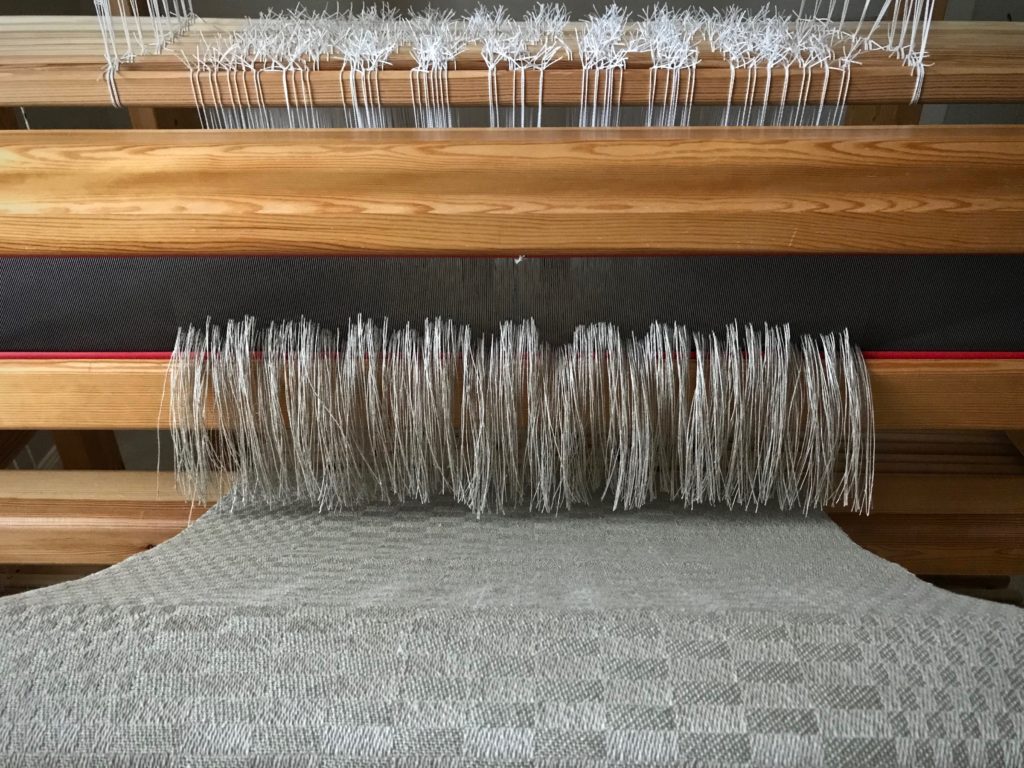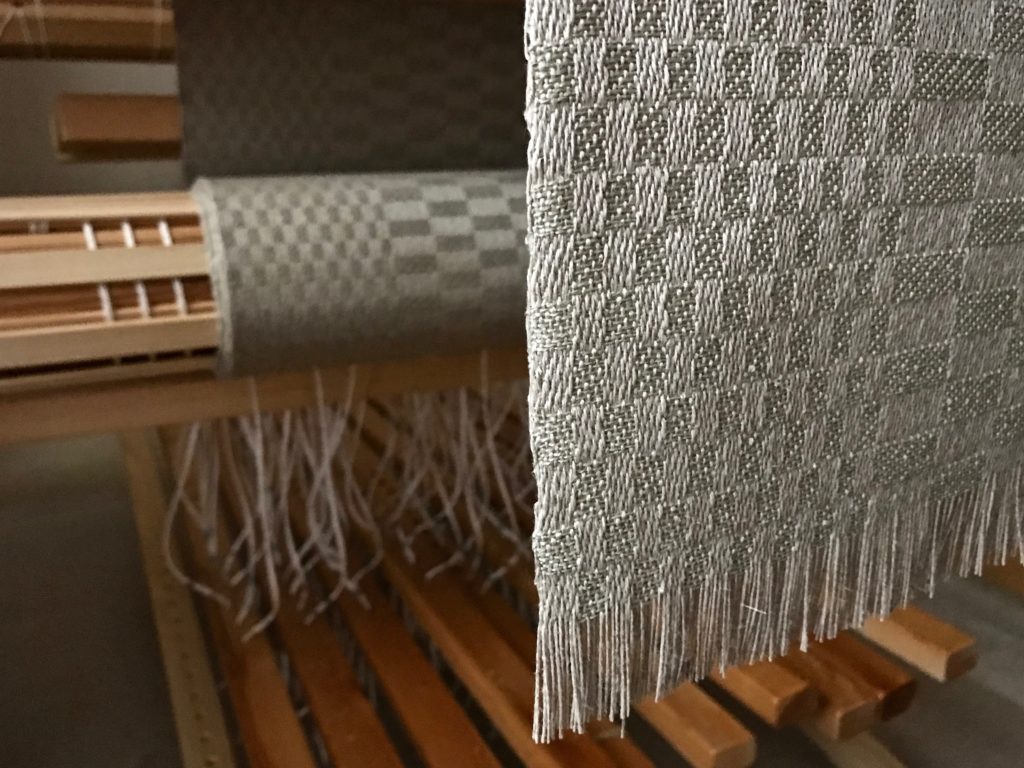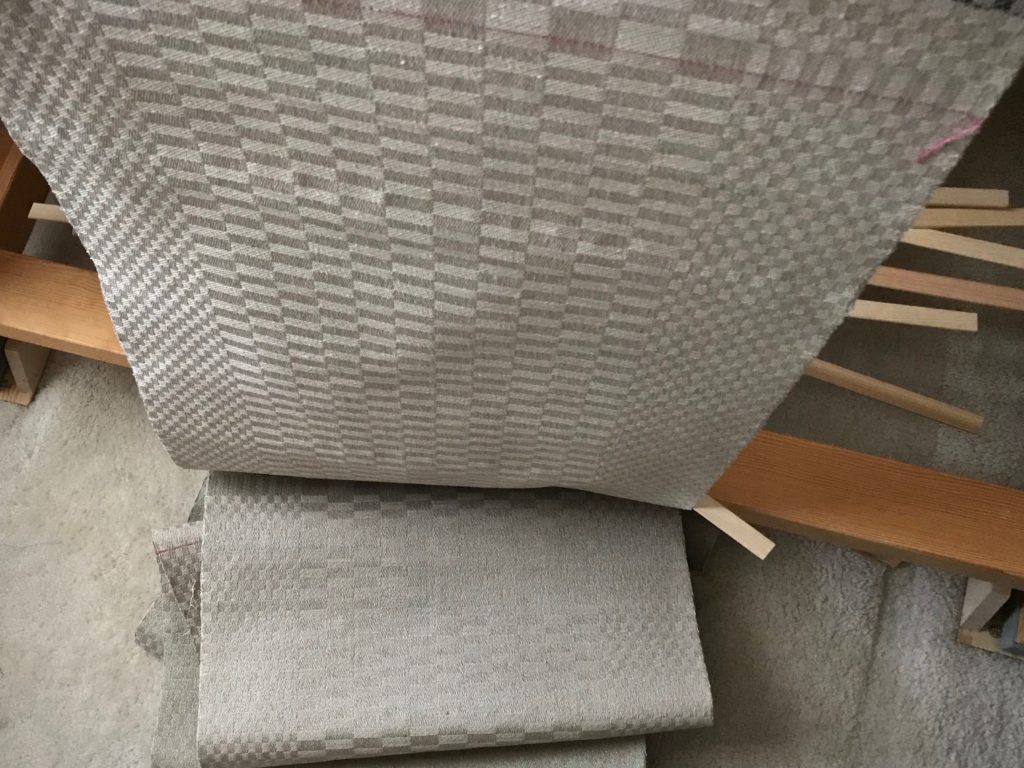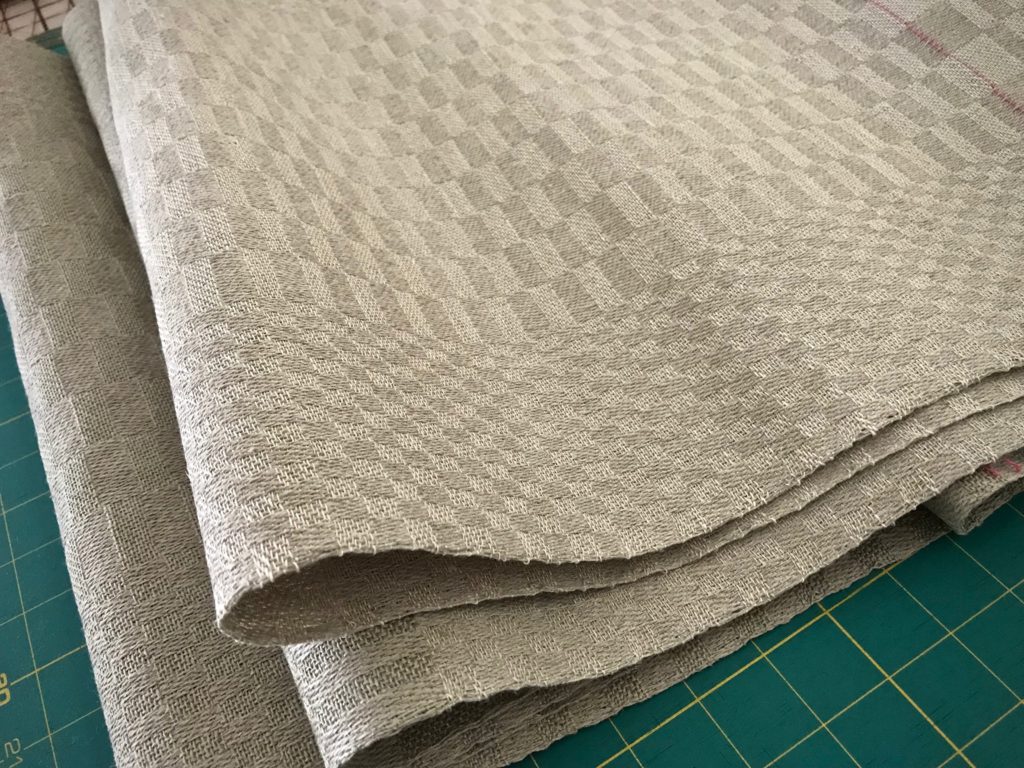There is beauty in cut threads. They signify completion. Look what has become of these linen threads! Order and sequence, timing and continuity, perseverance and pursuit. Through a weaver’s hands it all adds up to fabric made for a purpose.




Father. With God as our Father, we are on the receiving end of the process. Grace and peace, granted from the Father’s hand, shape our lives. And, like a good weaver, our Father makes something beautiful from the threads we offer him. Imagine the day when it may be said of us, “Look what became of the linen threads in the Grand Weaver’s hands!”
May your threads turn into something beautiful.
With joy,
Karen

Beautiful tribute to Our Father who IS the Masterweaver! I just finished the second project on my Baby Wolf and it was a major learning experience, so it is a miracle that, as I cut it off, it really became the towels I intended to do! Lessons: (1) Make sure that the warp goes OVER the back beam (2) count the heddles more carefully to avoid need to make repair heddles…which sometimes come loose! (3) Use the right equipment, e.g. raddle that spreads the threads so they are straight. But, they will come off the loom this a.m. I intend to continue doing the back to front warping until I learn it better…and I will do something in plain cloth, with at least some stripes. Thanks to many resources, I have choices! Thank you, Karen, for this timely message! God Bless!
Good Morning, Joyce, I think that you will find that every new warp on the loom is a new learning experience. Congratulations on finding solutions along the way! Neglecting to go over the back beam is a common one-time error. Call it “weaving initiation.” It’s the kind of error you only make one time. 😉
I don’t use a raddle. Instead, I pre-sley the reed, which is another easy way to spread the warp.
You are right, you have choices!
Grace to you, and peace from God our Father.
Happy weaving,
Karen
Goodness! They’re going to be luxurious towels.
Good Morning, Beth! Linen fabric captivates me because of the way it hides and reveals pattern depending on the light. I think that’s why linen works so well for satin damask, with it’s pattern of warp and weft floats. Yes, I guess handwoven linen satin damask is luxury. I feel very fortunate. :-j
Happy weaving,
Karen
Yourr weaving is lovely as are your words and writing!
Hi dear Shari, You are very kind! Thanks, that means so much to me.
Happy weaving,
Karen
Hi Karen!
I love your blog. I am just getting back to weaving after a 20 year hiatus. Your words of wisdom have been a great help. Your talking about cutting off the cloth brought to mind a question. What do you do with your loom waste?
Peaceful Weaving,
Kay
Hi Kay, Welcome back to the world of weaving! I’m so glad you wandered over here. Great question!!
Most of the time I discard the thrums (loom waste). However, I cannot get myself to throw away linen. So, I have several short chains of linen thrums hanging in my weaving studio. I have a few other chains of thrums of yarn that was too pretty or too long to justify throwing away. I have used cotton thrums as choke ties, using a few threads bundled together. But I have other choke ties that I prefer to use. There “should” be a good use of thrums, and I’ve heard of a few; but life (and space) is too short to keep everything that “could” be used someday. I did find a draft for linen washcloths that uses linen thrums in the weft. I have that on my list for this year’s weaving, so you’ll see with me how that works out. Who knows, that may open a whole new door for thrums!
Happy weaving,
Karen
Hello Karen,
These are so beautiful! Are they going to be dish towels?
You have inspired me to try this type of weave on my new loom (loom number three and counting)! Do you have a resource for learning how to weave satin damask? Also, what is the weight of the linen you are using and the set?
I hope you don’t mind me picking you brain:)
Thank you so much,
Kathryn
Hi Kathryn, These will be dish towels and/or hand towels.
Thanks for asking questions! It’s a pleasure to correspond about weaving.
The warp is 16/2 linen. The weft on two of the towels is 16/1 linen, which makes a nice elegant towel. My husband requested that I make some towels that are not as “sweet and sissy,” that are thicker and more hefty. So the remaining towels have 16/2 linen weft. I will know more after wet finishing, but I think these heftier towels will be very nice. If they end up being too stiff I may not cut them apart, and leave it as a long table runner.
Weaving this satin damask has been so enjoyable that I have already wound a warp to do it again, with a slightly different pattern. And, I’m doing it in 8/2 cotton this time (with a 65/10 metric reed, 13 epc).
You need ten shafts and ten treadles for this five-shaft satin in two blocks. I followed the draft and instructions for this from my favorite weaving book, “The Big Book of Weaving,” by Laila Lundell. I am using a 70/10 metric reed, and the sett is 14 ends per cm. With an Imperial reed, comparable would be an 18-dent reed, with 36 ends per inch.
Happy Weaving,
Karen
Karen, I love these towels. You mentioned that one of the things you do post look is correct mistakes. How do you do this and which mistakes can be corrected off loom. I’m always dismayed upon finding a mistake but have learned that nothing is perfect. Thank you for your blog. I look forward to it.
Maggie Ackerman
Hi Maggie, You ask a really good question. And you are so right that nothing is perfect. Thankfully, many weaving errors can be corrected off the loom. I think I shall do a blog post when I start fixing the errors on these towels. Thanks for the idea!
The main kind of errors I’m looking for are skipped threads or floats. These can usually be corrected, but it must be done BEFORE the fabric is washed. I use a blunt needle and needle-weave the matching thread, warp or weft, in the correct path of the weave, starting about an inch before, and going about an inch beyond the errant float. On a tight weave like these towels, I may need to use a magnifier to see what I’m doing.
The other kind of error that I want to take care of is a loop at the selvedge. Depending on the size of the loop, there are a couple ways I handle this. Either, cut the loop and sew it back into the fabric, or needle-weave in a new thread entirely. …or, just leave it and hope it will shrink in enough in the wash.
I hope this helps! Look for a blog post on the subject in the next couple weeks.
Happy weaving,
Karen
Such lovely towels, I adore the colors and the draft.
Hi Martha, I’m pleased with how they came out, too! I’m glad you like them.
All the best,
Karen